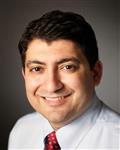Amir Zarrinpar (MD, PhD) is a gastroenterologist with UC San Diego Health, and a researcher at The Salk Institute for Biological Studies. His mouse research on the role of the gut microbiota in obesity and metabolic disease was presented earlier this year in a short talk at the 2015 Keystone Symposium, Gut Microbiota Modulation of Host Physiology. Zarrinpar answered some questions for GMFH editors about his work and how it can inform future studies on the gut microbiota in health and disease.

Dr. Amir Zarrinpar of San Diego, USA.
How are the gut microbiota of normal mice affected by when they eat?
One of the things that we noticed was that, during the dark or active phase of mice, the number of Firmicutes species went up, and during the light or inactive time it went down, whereas the Bacteriodetes… had the opposite cycle, where they went up during the light but came down during the dark. Normal mice… tend to have meals during the night [in their] active phase, and during the light they’re spending most of the time sleeping and not eating. So it seems like this rise in Firmicutes corresponds with this feeding behavior of them eating more during the dark period.
How does this differ in mice with diet-induced obesity?
Diet-induced obesity mice are different from normal mice in the sense that they tend to eat a little bit throughout the day and night. They don’t have this large meal during the dark phase. What we noticed was that for these animals it was basically all Firmicutes, all the time.
A normal mouse has a lot of fluctuations: about 17% of the OTUs [operational taxonomic units] we detected fluctuated. The diet-induced obesity mice had much less [fluctuation].
How were you able to protect against the negative metabolic effects of the high-fat diet?
We had another condition called the time-restricted feeding condition. These are the mice who consumed the same amount of high-fat diet as the diet-induced obesity mice, but because they [ate] it all during the narrow window of time, they [didn’t] become obese.
When we looked at all the differences between our time-restricted feeding mice and the diet-induced obesity mice, all the families of bacteria that seemed to be different between these two conditions were in families that have been hypothesized to be involved in metabolism and dysmetabolism. So for example, Lactobacilli were cyclical in normal mice [and] not so cyclical in diet-induced obesity mice, but in the time-restricted feeding mice, they were cyclical again. Their levels were also reduced. Lactobacilli are thought to be involved in steatohepatitis and insulin resistance.
How can this work inform future studies on the gut microbiota?
What this paper shows is that, first of all, the gut microbiome is really dynamic. In a normal mouse, it’s constantly changing. You can imagine that if you were measuring the microbiome early in the morning versus late at night, or late in the evening, you’re going to have completely different results. So the timing of when you collect your samples is going to be very important.
The other thing is that… for example, for two high-fat diet conditions, even though they were receiving the same amount of food, just the fact that they were feeding [at different times] caused changes in the microbiome. There are lots of things that affect the dynamics of the gut microbiome. We should be careful of them in research.
The other thing it seems to suggest is that the gut bacteria that influence metabolism are probably very few species; that was suggested by a lot of other studies as well.
Reference:
Zarrinpar A, et al. (2014) Diet and Feeding Pattern Affect the Diurnal Dynamics of the Gut Microbiome. Cell Metabolism. DOI: http://dx.doi.org/10.1016/j.cmet.2014.11.008

